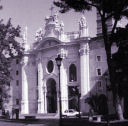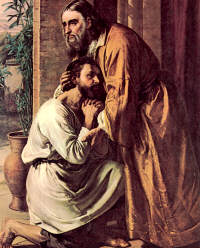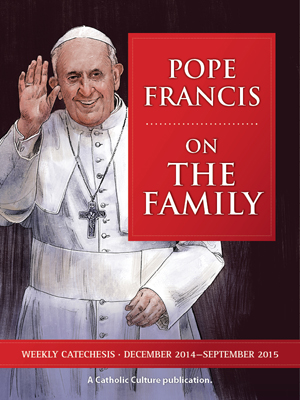» Enjoy our Liturgical Seasons series of e-books!
"Rejoice, Jerusalem! Be glad for her, you who love her; rejoice with her, you who mourned for her, and you will find contentment at her consoling breasts." This Sunday is known as Laetare Sunday and is a Sunday of joy. Lent is half over, and Easter is enticingly near.
This Sunday was formerly called "Laetare Sunday" since its mood and theme was one of hope and rejoicing that Easter was near. In the reformed calendar this Sunday is not different from the other Sundays of Lent even though the entrance antiphon for the day still begins with the Latin word "laetare" and the vestments worn by the celebrant are rose-colored, not violet. The day is important because it is the day of the second scrutiny in preparation for the baptism of adults at the Easter Vigil.

The Station in Rome is in the basilica of Holy Cross in Jerusalem, one of the seven principal churches of the holy city. It was built in the fourth century, by the emperor Constantine. The emperor's mother, St. Helen, enriched it with most precious relics, and wished to make it the Jerusalem of Rome.
Sunday Readings
The first reading, first Book of Samuel 16:1b, 6-7, 10-13a,l contains, at best, oblique references to the other two readings. The anointing of David as king may be a reference to the anointing in the responsorial psalm both of which may refer to Christ the good shepherd. The figure of David may also be a prefigurement of the anointing to Messiahship of Jesus for his mission. Whatever the reason for its selection for this day, the theme of the liturgy is better reflected in the other two readings for they present implications and applications of the baptism of the believer.
The reading from the Letter of St. Paul to the Ephesians 5:8-14 is particularly significant because throughout the season of Lent the community has been urged to cast aside deeds of darkness and walk in the brilliance of the light of Christ. In this reading, for the first time during Lent, the darkness-light theme which will be so predominant at Easter is enunciated. The believer must leave the deeds of darkness and live according to the justice and truth of God through the light of Christ. The selection of this reading for the Sunday liturgy of the second scrutiny emphasizes clearly that the preparation of a person coming to the faith is one of moral formation as well as in-formation about the faith. The preparation of adults to be baptized has more to do with choices and deeds than it does with dogmatic teaching.
The gospel reading, John 9:1-41, dominates the liturgy by the length of the reading and its significance. The miracle story of healing the man born blind is amplified in typical Johannine style by references and explanations about light, water, and Jesus' origins. The reference to Christ as the light of the world and to the symbolism of water as new birth is clear, for in his death and resurrection the sightless see eternal truths, and the "seeing" become blind because their former sight according to the vision of the world is now changed to the vision of Christ.
The discussion about Jesus' origins is a typical Johannine approach: if we know his parents, why can't we keep him under control? The point of the author is that if we ask this question we do not know his true origins at all for he is from above and to follow him where he goes requires a new birth for the believer.
The theme of light pervades the liturgy of the word; a light that is not a possession to be contained, but a gift which clarifies and illuminates the things of this world so that we do not rely upon human powers for our salvation, but acknowledge the divine origins of our Savior. — A Celebrants Guide to the New Sacramentary - A Cycle by Kevin W. Irwin

Fourth Sunday in Lent (Laetare Sunday)
Station with Santa Croce in Gerusalemme (Holy Cross In Jerusalem):
This church is one of the seven pilgrim churches in Rome. St. Helen, mother of the emperor Constantine, had a church built in Rome to house the relics of the Passion of Our Lord which she had obtained during her pilgrimage to the Holy Land. St. Helen discovered the true Cross of Our Savior with its title and the instruments of His death such as the nails and the crown of thorns. She had the top layer from Mount Calvary removed and placed in barges that carried this material to Rome. She then had the builders use this soil as the ground on which she had the basilica built for the sacred relics. The true Cross and other holy items have been kept in this basilica since its consecration in the fourth century and can be visited to this day. Because of the great relic enshrined there, the basilica is called the Holy Cross and because it is built on the soil from Mount Calvary it is said to be in Jerusalem.
For more on Santa Croce in Gerusalemme, see:
For further information on the Station Churches, see The Stational Church.
Rejoice, Jerusalem!
Uninterrupted sorrow is just as hard for man as uninterrupted joy. Who knows this better than the "mistress of psychology," Mother Church? She, therefore, inserts into this "season of affliction" a day of rest and joy "that we may have relief by the comfort of God's grace" (collect). Her altars are adorned with flowers, her chants perfumed with the music of the organ, her ministers clothed in the "dalmatic of joy," of a color which unites the purple of the forty penitential days with the white of the fast-approaching fifty Paschal days. "Laetare, Jerusalem," and so she rejoices today with all her children.
Joy is the keynote of the Mystical Body. Did not God's angel say so on the birthday of its divine Head? "I bring you tidings of great joy that shall be to all the people." "Laetare, Jerusalem!" These two words are more than an aggregate of sixteen letters. They are a message, a powerful reminder that, where the Holy Ghost operates and where souls co-operate with Him, there also must be joy, which is a fruit of the Holy Ghost.
Why is it that Christians often are so joyless? They act as though they were not redeemed, as though they were not branches of Him who is the cause and fountain of all joy. They walk as children of the "bond woman," the Testament of fear, when in reality they should live as sons and daughters of the "free woman," the Church of love, our Jerusalem (introit), our Mother at whose eucharistic breasts of consolation we drink the joyous "liberty wherewith Christ hath made us free" (epistle).
True, our whole life is a texture of sorrows and joys. Good Fridays and Easter days accompany us on our journey to the land of perennial Easter. But as there is no Good Friday without the assurance that "by the wood of the Cross joy has come into the whole world," so in the soul of a true Christian there is no sorrow bereft of the joy that will come from living faith, strong hope and sincere love: a joy ever sustained and increased by that wonderful Bread which Christ's loving hand multiplies for us in this desert of life.
How strikingly this truth is shown forth by the rose which our holy Father blesses on this day. Does not this queen of all flowers crown a stem of many thorns? Sorrows and joys! Such was the life of our Lord. Thirty-three years filled with thorns of sorrows until on the stem of the Cross He bloomed like a glorious rose filling the whole world with the fragrance of redemption and life. So it must be in the life of His followers, who are not greater than "the First-born among many brethren."
Remember the station of today: Holy Cross! By the wood of this Cross joy has come into the world, into your heart also. Laetare, Jerusalem! Endure the thorns of life courageously. Supernaturalize them. The rose-bud of joy is opening more and more until it reaches its perfection on the day when you will be able to chant: "I rejoice at the things that were said to me: we shall go into the house of the Lord," we shall now make our glorious "introit" into the eternal Jerusalem.
Then there will be no more thorns, only the rose of celestial fragrance, the rose that grew out of a thorn-clad rod of sorrow, blooming to your joy and to the joy of Him who by His precious blood obtained for you an unending "Laetare Jerusalem."
—From Martin Hellriegel, Vine and Branches






